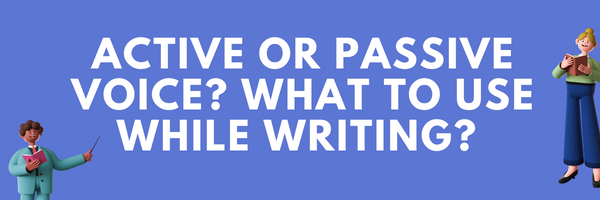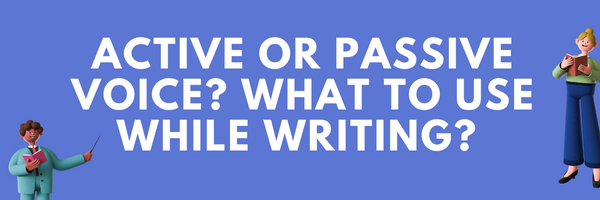

Remember Grade 5? The time when your teacher drew a line of division on the board and wrote ‘ACTIVE’ and ‘PASSIVE’ on either side of the line in capital letters, and took almost five lectures to complete the topic of “voice.”
We all have studied the difference between active and passive voice through a tabular description and must have solved various questions as practice exercises or in exams regarding the same. However, there has always been some kind of confusion as to which voice should be used while writing content? Before explaining active and passive voice usage in different situations or writing styles, let us revisit 5th Garde and discuss the difference between the two.
According to the Best U know, “An active voice is a sentence in which a verb shows that the subject does an action, whereas passive voice is the one in which the verb shows that the action is done to the subject. “In other words, in an active sentence, the person acting is the subject of the sentence, while in a passive sentence, the person or item acted upon is at the end of the sentence.
Now, as we are clear with what both mean and signify, we will understand the impact of active and Passive voice in content writing before delving deep into the topic of their usage.
You might have heard it from your teachers or others sources, one of them being Utah State University, that you should avoid using the passive voice as much as you can and focus on using active sentences. But why is that so? Using a particular voice affects the way you write your piece of article, and we will be highlighting few of the reasons for that:
1. Length of Sentences:
Using a specific voice can impact the length of the sentences in your content and make it either too long or short for the readers. Passive voice brings the acting person to the end of the sentence,making it wordier and challenging to process. Active Voice, on the other hand, makes it easier to read a sentence and understand it.
For example,
Passive voice- “The lion was killed by the hunter.”
Active voice- “The hunter killed the lion.”
2. Comprehension-
One would like to write content that can be easily comprehended and understood by the audience and be found useful and engaging. Voice can help in making the article quite engaging if they are used correctly and thoughtfully.
3. Identification:
Time is precious, and if someone is reading your content and giving their valuable time, you should also make an effort to make their process of reading and comprehending the article a bit easy. It should be easily understandable who is performing which action, and this can be done with the help of using voice accurately.
Passive sentences often make it difficult to identify who is acting, as the sentence’s subject is the person or item acted upon rather than the person who is performing the sentence. In active voice, although, it becomes easy to identify the performer as he/she is the subject of the sentence.
For example,
Passive voice-“The book was read by Jim in one day.”
Active voice- “Jim read the book in one day.”
In the above case, when you read the sentence in the active voice, you immediately identify that “Jim” is performing an activity. In contrast, in passive voice,you get to know about the person performing the action at the end of the sentence. It just makes the reader work hard for no reason.
Till now, we have learned a lot about the difference between active and passive voice and how they can impact our content. But what is more important is the situation and the time when we used them to make our content useful, interactive, and engaging.
Michel de Montaigne once said,
“The greater part of the world’s troubles are due to questions of grammar.”
According to the University of Wisconsin -Madison, active voice is always preferred in all sorts of writing than passive voice, be it scholarly writing or fiction, academic reports or blogs, etc., because passive voice is vague, difficult to comprehend, and in addition to that it makes the sentences too wordy and hard to read.
However, some circumstances in which using a passive voice in the sentence are preferred to an active one are mentioned below:
1. Focus is on action rather than the agent-
In situations in which the author wants to focus on what is being happened rather than the person who is performing the event, passive voice is preferred over active as it brings the action to the subject of the sentence and shifts the focus of the readers’ attention on the action than the agent.
For example,
Passive voice- “Jack was knocked down by the opponent in the fight.”
Active voice- “The opponent knocked down Jack last night.”
In the above case, it will be preferable to use passive voice as the main focus is to transmit what happened to Jack rather than who knocked him down.
2. The actor is unknown or wants to be hidden or is irrelevant:
In this case, it is better to choose passive voice,as in it the agent or person who has performed the action is mentioned at the end of the subject or is actually hidden i.e. nowhere mentioned.
Generally, this trick is used by mystery writers when they don’t want to disclose who had performed the action and keep things vague.
For example, if you don’t want to tell who has eaten all the cookies, you can say, “All cookies have been eaten” (passive voice) rather than “Marie ate all the cookies.”
This way, using passive voice in the sentence is helpful in hiding the complete truth and lets the audience wonder who the actual culprit is.
3. Keep the focus consistent throughout the article or passage:
If a content creator wants to focus on a particular subject or thing throughout the passage, then passive voice shall be used as it will help keep the attention to a particular thing and serve the author’s purpose.
For example, “The Department of Chemistry presented what proved to be a controversial report on nucleus diffusion. It was after a long debate, the report proposed by the Department of chemistry was presented in front of the Post-Graduate Chemistry students.
4. Authoritative Tone:
When you want to show confidence, power, and authority, especially about rules and regulations, it is always better to use the passive voice because, with its help, one can avoid mentioning the actors and give a sense of authority to the reader.
For example, we could say:
The museum prohibits visits after 5 o’clock.
This sentence seems perfectly fine when it comes to grammar, but if we wish to highlight the action, which is the prohibition of visiting after a specific time, and make it look more authoritative rather than obligatory, one could rewrite the sentence in the passive tone.
Visitors are prohibited after 5 o’clock.
By omitting the actor, you can turn the phrase into a rule or law and make it look more powerful and authoritative.
When used thoughtfully and accurately, passive voice can be a helpful tool, but in most situations, active voice is used to make the sentence and the content shorter, livelier, unambiguous, and concise.
Daniel J Boorstin rightly said, “The traveler was active; he went strenuously in search of people, of adventure, of experience. The tourist is passive; he expects interesting things to happen to him; He goes ‘sight-seeing’.
REFERENCES:
http://www.usu.edu/markdamen/WritingGuide/CGGS/400passiveintro.htm
https://www.copypress.com/blog/importance-active-voice-content/
https://www.plainlanguage.gov/guidelines/conversational/use-active-voice/
http://www.biomedicaleditor.com/passive-voice.html
#contentmarketing #aiwriting #content #proofreading #writingsoftware
